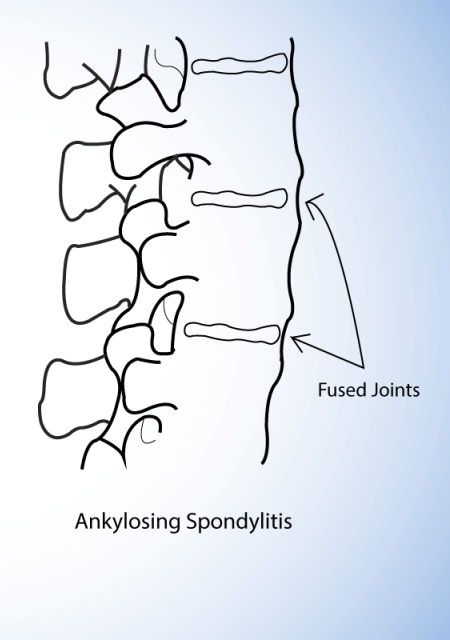Ankylosing spondylitis is a chronic inflammatory condition that affects the spine and other joints. It can cause pain, stiffness, and loss of mobility in the affected joints, and can significantly impact a person’s quality of life. Ankylosing spondylitis typically develops in early adulthood, and can progress over time if left untreated.
The exact cause of ankylosing spondylitis is unknown, but it is believed to have a genetic component. Men are more likely to develop ankylosing spondylitis than women, and it often runs in families. The condition typically starts in the lower back and can progress up the spine, leading to fusion of the vertebrae and loss of flexibility.
Common symptoms of ankylosing spondylitis include pain and stiffness in the lower back, hips, and neck. This can make it difficult to perform daily activities, such as walking, bending, and reaching. In more severe cases, ankylosing spondylitis can also cause inflammation and pain in other joints, such as the shoulders, knees, and ankles.

There is supposedly no cure for ankylosing spondylitis, but there are a variety of treatment options that can help manage symptoms and slow the progression of the condition. This can include medication to reduce inflammation and pain, physical therapy to improve range of motion and strength, and surgery in severe cases. The power of the Zone Technique and it’s ability to turn on the awesome healing ability of the body makes this a great choice to manage, slow down the progression of, or potentially reverse ankylosing spondylitis and the problems that it causes.
Chiropractic care can also be a beneficial treatment option for ankylosing spondylitis. Chiropractors are trained to diagnose and treat musculoskeletal conditions, including ankylosing spondylitis. Typical chiropractic treatment for ankylosing spondylitis typically involves a combination of spinal adjustments, soft tissue mobilization, and therapeutic exercises.
Spinal adjustments can help improve the alignment and mobility of the spine, which can reduce pain and stiffness. Soft tissue mobilization techniques, such as massage and stretching, can help improve blood flow and reduce muscle tension. Finally, therapeutic exercises can help improve strength, flexibility, and range of motion, which can help maintain joint function and reduce the risk of further injury.
One of the main benefits of chiropractic care for ankylosing spondylitis is that it can help reduce pain, increase range of motion, and make it easier to move without the need for medication or surgery. Chiropractic care can also help improve overall physical function, which can have a positive impact on a person’s quality of life.
It has been said that it is important to note that chiropractic care for ankylosing spondylitis should be done in conjunction with other forms of medical treatment, such as medication and physical therapy. However, medicine and physical therapy have no answers at all when it comes to this condition. “Regular” or “typical” chiropractic care is not a substitute for medical treatment, but can be a valuable adjunct therapy to help manage symptoms and improve overall physical function. On the other hand, being treated by a chiropractor or other practitioner who is Certified in Zone Technique is the real answer.
Chiropractic Care Utilizing Zone Technique for Ankylosing Spondylitis
Any Zone Technique healer, including Dr. Post, knows exactly what to do for any condition walking into the office, including ankylosing spondylitis and its associated symptoms. Since Zone Technique is able to unlock and unleash the powerful healing ability withing your body, your healing results will be significantly better than any other healing technique available today – especially medicine. Whether you have or someone else you know has ankylosing spondylitis, balancing the body by utilizing Zone Technique will heal your body on a very deep level. Zone Technique healing is natural, effective, and permanent so that you will heal, function great and no longer have pain. You can be totally healthy again – feeling great and functioning perfectly from head to toe every day of the year!
If you don’t live close enough to see Dr. Post, search for a certified Zone Technique healer closer to you by searching the ZONE TECHNIQUE PRACTITIONER DIRECTORY. You owe it to yourself to take action so that you can heal and feel awesome again.
If you are experiencing symptoms of ankylosing spondylitis, it’s important to seek treatment from a healthcare professional. Chiropractic care obtained from a Certified Zone Technique Practitioner is the safest and most effective treatment option for ankylosing spondylitis, and can help you improve your quality of life by reducing pain, increasing range of motion, and making it easier to move without negative side-effects. With proper care, people with ankylosing spondylitis can move easily again and feel great every day.

